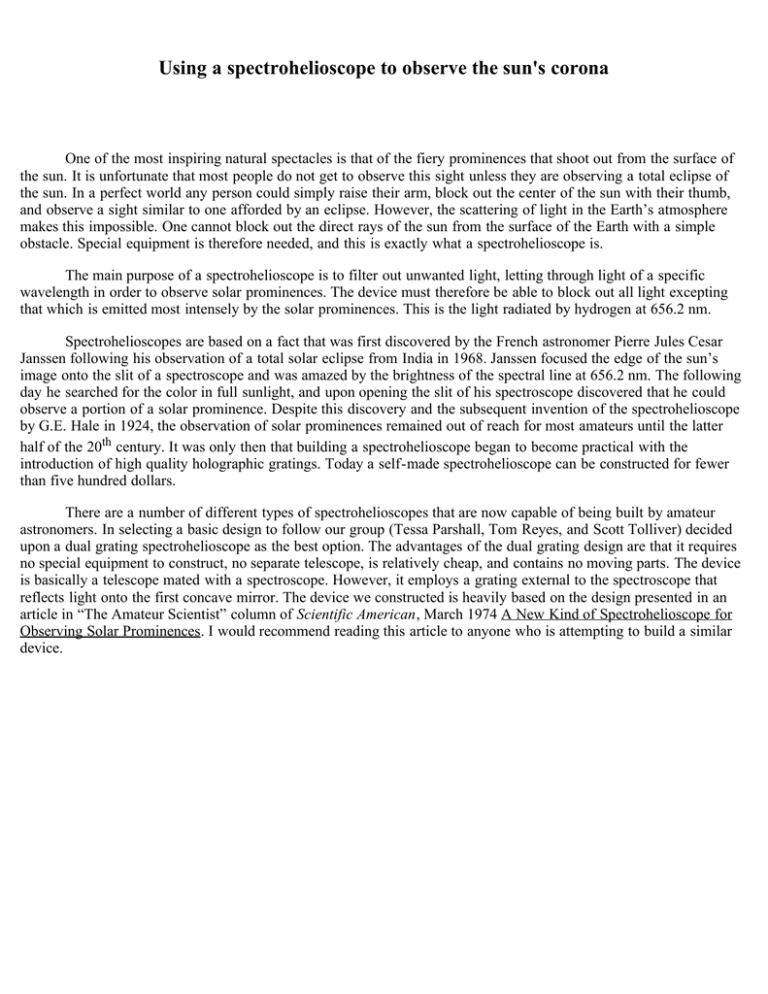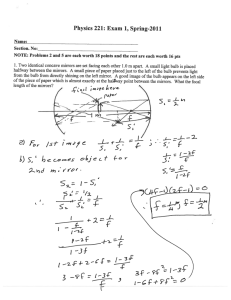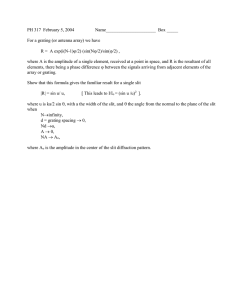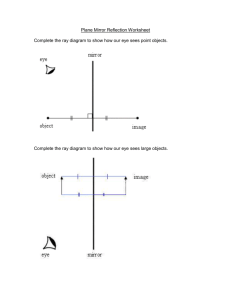Using a spectrohelioscope to observe the sun's corona
advertisement

Using a spectrohelioscope to observe the sun's corona One of the most inspiring natural spectacles is that of the fiery prominences that shoot out from the surface of the sun. It is unfortunate that most people do not get to observe this sight unless they are observing a total eclipse of the sun. In a perfect world any person could simply raise their arm, block out the center of the sun with their thumb, and observe a sight similar to one afforded by an eclipse. However, the scattering of light in the Earth’s atmosphere makes this impossible. One cannot block out the direct rays of the sun from the surface of the Earth with a simple obstacle. Special equipment is therefore needed, and this is exactly what a spectrohelioscope is. The main purpose of a spectrohelioscope is to filter out unwanted light, letting through light of a specific wavelength in order to observe solar prominences. The device must therefore be able to block out all light excepting that which is emitted most intensely by the solar prominences. This is the light radiated by hydrogen at 656.2 nm. Spectrohelioscopes are based on a fact that was first discovered by the French astronomer Pierre Jules Cesar Janssen following his observation of a total solar eclipse from India in 1968. Janssen focused the edge of the sun’s image onto the slit of a spectroscope and was amazed by the brightness of the spectral line at 656.2 nm. The following day he searched for the color in full sunlight, and upon opening the slit of his spectroscope discovered that he could observe a portion of a solar prominence. Despite this discovery and the subsequent invention of the spectrohelioscope by G.E. Hale in 1924, the observation of solar prominences remained out of reach for most amateurs until the latter half of the 20th century. It was only then that building a spectrohelioscope began to become practical with the introduction of high quality holographic gratings. Today a self-made spectrohelioscope can be constructed for fewer than five hundred dollars. There are a number of different types of spectrohelioscopes that are now capable of being built by amateur astronomers. In selecting a basic design to follow our group (Tessa Parshall, Tom Reyes, and Scott Tolliver) decided upon a dual grating spectrohelioscope as the best option. The advantages of the dual grating design are that it requires no special equipment to construct, no separate telescope, is relatively cheap, and contains no moving parts. The device is basically a telescope mated with a spectroscope. However, it employs a grating external to the spectroscope that reflects light onto the first concave mirror. The device we constructed is heavily based on the design presented in an article in “The Amateur Scientist” column of Scientific American, March 1974 A New Kind of Spectrohelioscope for Observing Solar Prominences. I would recommend reading this article to anyone who is attempting to build a similar device. The diagram above schematically represents both the optical layout and the actual shape of the enclosure that was employed. The first grating acts as the input to the scope and reflects a dispersed image of the sun onto the first mirror in the system. The mirror then collects and focuses the light. The mirror should be configured so that it is focused precisely on the slit. This is best done by adjusting the first grating to reflect the 0-order light or replacing it with a mirror so you are actually focusing a full image on the slit. It is important to remember to use a light source that will simulate the distance to the sun (essentially at infinity). On the way to the slit, the light reflected from the first mirror will pass through the tuner, which is merely a rotatable plate of flat glass. This allows the beam to be displaced laterally in relation to the slit allowing adjustments to the tuner to select which wavelengths of light will pass through the slit. At this point in the optical path, we have a number of monochromatic images of the sun’s disk which overlap each other on each side of the hydrogen spectral line at 656.2 nm. The selected wavelength of light emerges from the slit as a diverging beam. It is then reflected by two plane mirrors onto a second concave mirror that will subsequently focus onto the second grating. The second grating then disperses the overlapping images of the sun’s disk. Properly adjusted the second grating will allow a monochromatic image consisting solely of light emitted by hydrogen to be reflected onto the third and final concave mirror. This mirror then focuses the image with the help of a lens, and the image is reflected off of a plane mirror to the eyepiece for viewing. The most crucial components of this system are the diffraction gratings. They should be chosen specifically for their purpose. They should be ruled with at least 1,200 lines per millimeter in order to insure adequate resolution and dispersion. They should also be blazed to reflect the desired light most intensely; thus gratings blazed for around 660 nm are preferred. The dimensions of the gratings should also be chosen carefully. You want to make sure that the ruled area of the gratings does not exceed the size of the mirrors that you are using. The dimensions of the gratings that we employed were 50mm x 50mm. Great care should also be taken in mounting the gratings. The mounts need to be adjustable in order to allow a proper alignment. We secured our gratings to a piece of wood using three metal clips padded with felt (so as not to damage the surface of the grating) and screws of the appropriate length. This mount was then secured to the side of the enclosure with three bolts. There were springs placed between the mount and the side of the enclosure, and the bolts were secured with wing nuts allowing us to freely adjust the angle of the gratings. We also employed wedges between the gratings and the mounts in order to achieve a proper angle. The wedges could have been avoided if we had taken the necessary angle into consideration with our initial design. Secondary in importance to the gratings is the mirrors. The size and focal lengths of the mirrors will be the single largest determining factor in the size and shape of the necessary enclosure for the device. In this instance we were forced to work with the materials that were at hand and available to us. Therefore our mirrors consisted of two 3” diameter spherical mirrors with focal lengths of approximately 30” and 20”, and a third mirror 2” in diameter with a focal length of approximately 30”. The use of these particular mirrors in combination with a miscalculation in our initial design resulted in the necessary modifications to the design presented in the Scientific American article that we were working from. Presented with the option of choosing the mirrors to be used, we would recommend one 3” spherical mirror of 30” focal length to be used as the first mirror in the system, and two 2.5” mirrors of 20” focal length to be used as the second and third mirrors. This will allow for a more compact device than the one that we constructed, and allow you to follow the original design more closely than we were forced to. We chose to utilize a mounting mechanism identical to the one that was utilized for the gratings. The mirrors were secured to wood blocks with three screws and padded metal clips, and the blocks were secured to the enclosure with three spring-loaded bolts using wing nuts. In this instance this design allowed us more than enough room to make the proper adjustments needed for the mirrors. The tuner can be constructed of any optically flat glass. It should be approximately 50 mm wide and 6-10 mm thick. The crucial attribute of the tuner is that it must be adjustable. In order to achieve this we mounted our tuner to a piece of plastic that was attached to a small metal rod with a ball bearing. We acquired the ball bearing from a motor that was available to us and no longer needed. This allowed the tuner to spin freely on the attached rod, but did not provide a mechanism for adjustment. In order to achieve this (along with the height necessary to place the tuner in the correct position inside the enclosure) we planted the rod into a block of wood and placed a wooden rod of adequate length to reach outside the enclosure vertically beside it. Joining the two via a rubber band allowed a twisting of the wooden rod to impart a twist to the tuner. The picture below make things more clear. While this system may be somewhat crude, it does work. However, during the use of this device it may be advantageous to have a somewhat finer control of the tuner’s position. Therefore, we would recommend either the use of a more complex gearing system or the use of a dial as described in the 1974 Scientific American article referenced. Also visible in the picture above, although slightly obscured, is the slit. It is constructed of four pieces of plexiglass bolted together in a parallelogram. Two razor blades were then glued to the long vertical pieces. The gap between the edges of the razor blades is what constitutes the slit. Pushing on the end of one of the horizontal pieces results in the two vertical pieces being moved either closer together or further apart. This either closes or widens the gap between the two razor blades, allowing the width of the slit to be adjusted. The parallelogram structure can be constructed of any material. We chose plexiglass because there were conveniently sized pieces at hand. It would be perfectly acceptable to construct the slit out of wood, and this is what we would recommend. We held our slit in position by gluing one edge to a piece of wood that extends into the enclosure. This both allows the slit to be adjusted while remaining essentially stationary, and blocks any stray light from the first diffraction grating. The picture below shows an interior view of the spectrohelioscope with the top cover removed. The rainbow pattern is produced by light from the camera flash reflecting off the second diffraction grating, which can be seen above the rainbow to the right of the lens. All of the plane mirrors that we used were already in mounts that we secured to blocks of wood with the use of screws. This was necessary in order to achieve the proper height relative to the mirrors and gratings. The purpose behind the first set of mirrors is to fold the optical path in order to get a proper distance from the slit to the second mirror. This allows us to position all three mirrors along the same side of the enclosure, and shorten the necessary size of the device. The last mirror is used to form the image at the eye piece. The lens became necessary because of the focal lengths of the mirrors that we used. Using these mirrors and the dimensions that we chose for our enclosure, we could not form an image at an acceptable distance from the third mirror. We therefore employed a lens in order to focus the light into an image at a much shorter distance. This allowed us to avoid modifying the construction of the enclosure. The lens was placed into a block of wood with a round hole of appropriate size cut out, and mounted to the side of the enclosure using screws. The eyepiece was simply attached to a piece of plastic tubing, and that tubing was then glued to the inside of an appropriately sized hole that was drilled into the side of the enclosure. The enclosure itself was made from a combination of wood and sheets of steel. The sides of the box (to which the mirrors and gratings were mounted) were constructed of wood, while the top and bottom were comprised of thin sheets of steel. Our rationale was that the wooden frame would provide the necessary strength and would be easy to work with, while using metal for the top and bottom would save weight making the device more portable. In hindsight we would recommend constructing at least the bottom of the enclosure out of wood as well. While this may add some weight to the device, we feel the trouble encountered using sheet metal was not worth it. The metal bottom introduced several problems in mounting components inside the enclosure. We had not planned on extending a piece of wood into the enclosure, but we ended up needing it in order to mount the slit properly. This actually turned out to have a good side effect in that it blocks stray light from the first grating, however we were also forced to screw the blocks supporting the plane mirrors into the sides of the enclosure. This limited us in our choices of possible locations. Also, the only recourse we could conceive of for attaching the tuner was to glue it to the bottom. We would have preferred to use a more secure method but screwing through the metal sheet proved to be problematic. The flared side of the enclosure was necessary in order to create the proper viewing angle to the first grating. The opening through which the sunlight enters is located here (as seen in the picture above). The only requirement for this opening is that it be large enough so that the entire ruled area of the grating is illuminated. I recommend an opening approximately ½” larger in diameter than the grating, therefore an opening about 2 ½” in diameter should be sufficient. One thing that may have been noticed in the above picture is that much of the inside of the enclosure is painted flat black. This was done in an attempt to negate the effects of stray light. We highly recommend this as well as covering all the surfaces not painted with black felt, and created barriers between mirrors using black felt in order to further block out any unnecessary light. The best piece of advice that I could give to anyone wishing to construct a similar device would be to spend an adequate amount of time on the design phase before beginning construction of the device. Pay very close attention to the focal lengths of the mirrors that you have chosen, and the resulting optical path lengths that will be necessary. Also, take into account a necessary margin for error regarding the distance your mounts will push your mirrors and grating from the sides of your enclosure. Because we wanted to finish this project in approximately three weeks, we rushed through the design phase and made what could have been a disastrous mistake regarding the size and shape of the enclosure that we wished to build. A subsequent redesign of our device allowed us to overcome this, however others who make the same mistake may not be quite so lucky. The biggest question now is of course how well does this thing work. The answer is that we don’t know quite yet. Unfortunately we have not had the opportunity to use the device to make any observations as the weather was poor since we finished the project. However, we have been able to observe other light sources, such as spectra from a hydrogen tube, and the device seems to be working properly at this point. References and useful links: A New Kind of Spectrohelioscope for Observing Solar Prominences. C.L. Stong. “The Amateur Scientist”, Scientific American, March 1974. Construction Of A Dual Grating Prominence Telescope. Michael Hill. www.spectrohelioscope.net/Construction%20Of%20A%20Dual%20Grating%20Prominence%20Telescope.doc http://spectrohelioscope.org/Higgins/SHS02.htm http://home.ust.hk/~westland/spectroh1.htm






